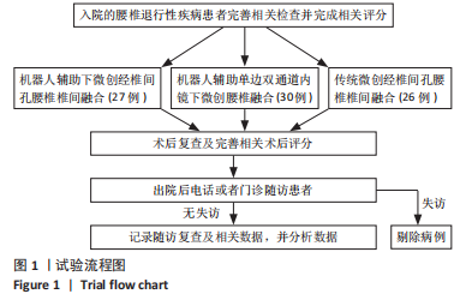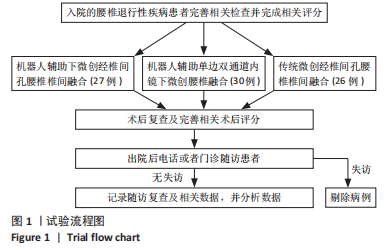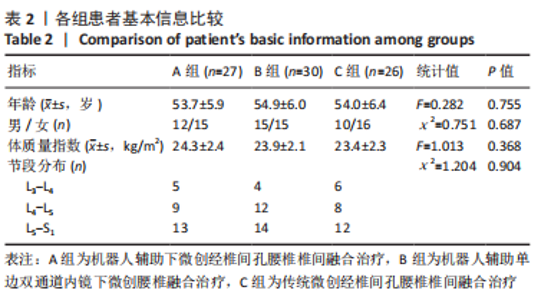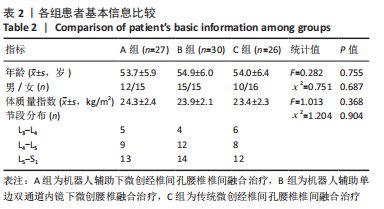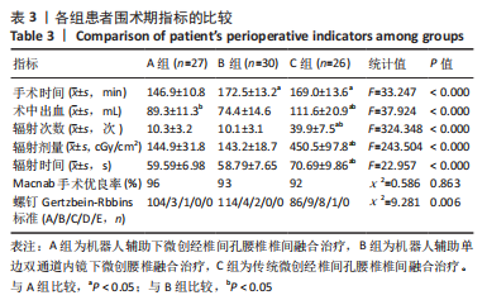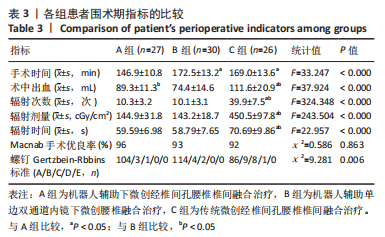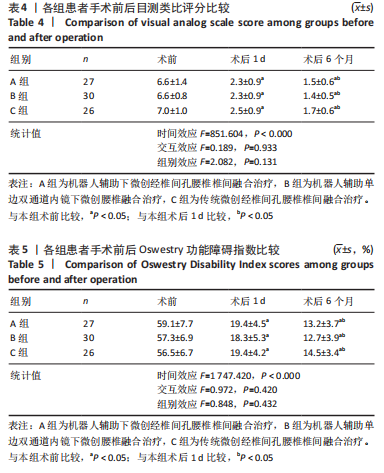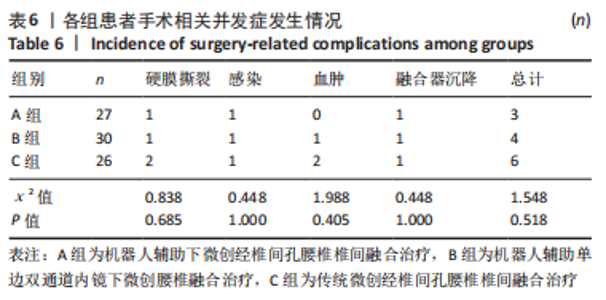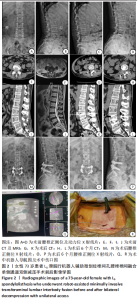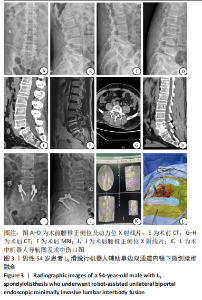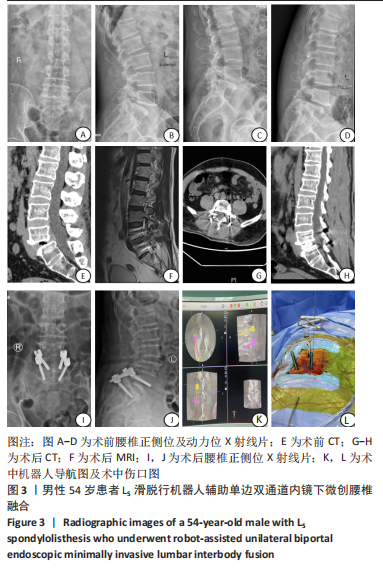Chinese Journal of Tissue Engineering Research ›› 2024, Vol. 28 ›› Issue (12): 1855-1862.doi: 10.12307/2024.025
Previous Articles Next Articles
Robot-assisted minimally invasive transforaminal lumbar interbody fusion in treatment of lumbar degenerative diseases
Li Ting1, 2, Liao Wenao1, 3, Zhong Wenjie1, 4, Liu Xilin1, Wang Fei1, Hu Jiang1
- 1Department of Orthopedics, Sichuan Academy of Medical Sciences & Sichuan Provincial People’s Hospital, Chengdu 610072, Sichuan Province, China; 2Department of Postgraduate, Chengdu Medical College, Chengdu 610500, Sichuan Province, China; 3Department of Postgraduate, University of Electronic Science and Technology of China, Chengdu 611731, Sichuan Province, China; 4Department of Postgraduate, Chengdu Sport University, Chengdu 610041, Sichuan Province, China
-
Received:2023-01-13Accepted:2023-03-21Online:2024-04-28Published:2023-08-22 -
Contact:Liu Xilin, MD, Attending physician, Department of Orthopedics, Sichuan Academy of Medical Sciences & Sichuan Provincial People’s Hospital, Chengdu 610072, Sichuan Province, China -
About author:Li Ting, Master candidate, Department of Orthopedics, Sichuan Academy of Medical Sciences & Sichuan Provincial People’s Hospital, Chengdu 610072, Sichuan Province, China; Department of Postgraduate, Chengdu Medical College, Chengdu 610500, Sichuan Province, China -
Supported by:Key Project of Sichuan Science and Technology Department, No. 2021YFS0383 (to LXL)
CLC Number:
Cite this article
Li Ting, Liao Wenao, Zhong Wenjie, Liu Xilin, Wang Fei, Hu Jiang. Robot-assisted minimally invasive transforaminal lumbar interbody fusion in treatment of lumbar degenerative diseases[J]. Chinese Journal of Tissue Engineering Research, 2024, 28(12): 1855-1862.
share this article
Add to citation manager EndNote|Reference Manager|ProCite|BibTeX|RefWorks
| [1] DU J, YAND J, YAN L, et al. Intraoperative anti-inflammatory drugs combined with no drainage after MIS-TLIF in the treatment of recurrent lumbar disc herniation: an RCT. J Orthop Surg Res. 2021;16(1):20. [2] FOLEY KT, HOLLY LT, SCHWENDER JD. Minimally invasive lumbar fusion. Spine. 2003;28(15 Suppl):S26-S35. [3] HEO DH, SON SK, EUM JH, et al. Fully endoscopic lumbar interbody fusion using a percutaneous unilateral biportal endoscopic technique: technical note and preliminary clinical results. Neurosurg Focus. 2017; 43(2):E8. [4] KIM CH, EASELEY K, LEE JS, et al. Comparison of Minimally Invasive Versus Open Transforaminal Interbody Lumbar Fusion. Global Spine J. 2020;10(2 Suppl):143s-150s. [5] HERREN C, REIJNEN M, PISHNAMAZ M, et al. Incidence and Risk Factors for Facet Joint Violation in Open Versus Minimally Invasive Procedures During Pedicle Screw Placement in Patients with Trauma. World Neurosurg. 2018;112:e711-e718. [6] 李亭, 刘希麟, 王飞, 等. 机器人辅助微创经椎间孔腰椎椎间融合治疗腰椎退行性疾病:置钉精度及其安全性[J]. 中国组织工程研究, 2022,26(36):5812-5818. [7] LI T, YAN J, HU J, et al. Efficacy and safety of electroacupuncture for carpal tunnel syndrome (CTS): A systematic review and meta-analysis of randomized controlled trials. Front Surg. 2022;9:952361. [8] LI T, YAN J, REN Q, et al. Efficacy and Safety of Lumbar Dynamic Stabilization Device Coflex for Lumbar Spinal Stenosis: A Systematic Review and Meta-analysis. World Neurosurg. 2023;170:7-20. [9] KOC M, BAYAR B, BAYAR K. A Comparison of Back Pain Functional Scale With Roland Morris Disability Questionnaire, Oswestry Disability Index, and Short Form 36-Health Survey. Spine. 2018;43(12):877-882. [10] SWANSON BT, CREIGHTON D. The degenerative lumbar disc: not a disease, but still an important consideration for OMPT practice: a review of the history and science of discogenic instability. J Man Manip Ther. 2020;28(4):191-200. [11] LI Y, DAI Y, WANG B, et al. Full-Endoscopic Posterior Lumbar Interbody Fusion Via an Interlaminar Approach Versus Minimally Invasive Transforaminal Lumbar Interbody Fusion: A Preliminary Retrospective Study. World Neurosurg. 2020;144:e475-e482. [12] DERMAN PB, ALBERT TJ. Interbody Fusion Techniques in the Surgical Management of Degenerative Lumbar Spondylolisthesis. Curr Rev Musculoskelet Med. 2017;10(4):530-538. [13] MOBBS RJ, PHAN K, MALHAM G, et al. Lumbar interbody fusion: techniques, indications and comparison of interbody fusion options including PLIF, TLIF, MI-TLIF, OLIF/ATP, LLIF and ALIF. J Spine Surg. 2015; 1(1):2-18. [14] HAWS BE, KHECHEN B, NARAIN AS, et al. Iliac Crest Bone Graft for Minimally Invasive Transforaminal Lumbar Interbody Fusion: A Prospective Analysis of Inpatient Pain, Narcotics Consumption, and Costs. Spine. 2018;43(18):1307-1312. [15] EUN SS, EUM JH, LEE SH, et al. Biportal Endoscopic Lumbar Decompression for Lumbar Disk Herniation and Spinal Canal Stenosis: A Technical Note. J Neurol Surg A Cent Eur Neurosurg. 2017;78(4):390-396. [16] KIM HJ, JUNG WI, CHANG BS, et al. A prospective, randomized, controlled trial of robot-assisted vs freehand pedicle screw fixation in spine surgery. Int J Med Robot. 2017;13(3). doi: 10.1002/rcs.1779. [17] 李亭, 张伟, 胡豇, 等. 机器人辅助微创手术与非手术治疗在胸腰椎损伤分类与严重度评分4分胸腰椎骨折患者中的临床疗效研究[J]. 华西医学,2022,37(10):1460-1464. [18] 陈盼, 郑丹扬, 丁伟国, 等. 单边双通道内镜下椎间盘切除术治疗高度游离型腰椎间盘突出症[J]. 中国修复重建外科杂志,2022, 36(7):860-865. [19] PRANATA R, LIM MA, VANIA R, et al. Biportal Endoscopic Spinal Surgery versus Microscopic Decompression for Lumbar Spinal Stenosis: A Systematic Review and Meta-Analysis. World Neurosurg. 2020;138: e450-e458. [20] YANG JS, HE B, TIAN F, et al. Accuracy of Robot-Assisted Percutaneous Pedicle Screw Placement for Treatment of Lumbar Spondylolisthesis: A Comparative Cohort Study. Med Sci Monit. 2019;25:2479-2487. [21] MOLLIQAJ G, SCHATLO B, ALAID A, et al. Accuracy of robot-guided versus freehand fluoroscopy-assisted pedicle screw insertion in thoracolumbar spinal surgery. Neurosurg Focus. 2017;42(5):E14. [22] MACKE JJ, WOO R, VARICH L. Accuracy of robot-assisted pedicle screw placement for adolescent idiopathic scoliosis in the pediatric population. J Robot Surg. 2016;10(2):145-150. [23] PREDOME-PANTOJA A, ISHIDA W, ZYGOURAKIS C, et al. Accuracy of Current Techniques for Placement of Pedicle Screws in the Spine: A Comprehensive Systematic Review and Meta-Analysis of 51,161 Screws. World Neurosurg. 2019;126:664-678.e3. [24] FU W, TONG J, LIU G, et al. Robot-assisted technique vs conventional freehand technique in spine surgery: A meta-analysis. Int J Clin Pract. 2021;75(5):e13964. [25] YU L, CHEN X, MARGALIT A, et al. Robot-assisted vs freehand pedicle screw fixation in spine surgery - a systematic review and a meta-analysis of comparative studies. Int J Med Robot. 2018;14(3):e1892. [26] LIU H, CHEN W, WANG Z, et al. Comparison of the accuracy between robot-assisted and conventional freehand pedicle screw placement: a systematic review and meta-analysis. Int J Comput Assist Radiol Surg. 2016;11(12):2273-2281. [27] LI HM, ZHANG RJ, SHEN CL. Accuracy of Pedicle Screw Placement and Clinical Outcomes of Robot-assisted Technique Versus Conventional Freehand Technique in Spine Surgery From Nine Randomized Controlled Trials: A Meta-analysis. Spine. 2020;45(2):E111-E119. [28] LI C, LI W, GAO S, et al. Comparison of accuracy and safety between robot-assisted and conventional fluoroscope assisted placement of pedicle screws in thoracolumbar spine: A meta-analysis. Medicine. 2021;100(38):e27282. [29] HYUN SJ, KIM KJ, JAHNG TA, et al. Minimally Invasive Robotic Versus Open Fluoroscopic-guided Spinal Instrumented Fusions: A Randomized Controlled Trial. Spine. 2017;42(6):353-358. [30] AGARWAL N, WHITE MD, ZHANG X, et al. Impact of endplate-implant area mismatch on rates and grades of subsidence following stand-alone lateral lumbar interbody fusion: an analysis of 623 levels. J Neurosurg Spine. 2020:1-5. doi: 10.3171/2020.1.SPINE19776. [31] YAO YC, CHOU PH, LIN HH, et al. Risk Factors of Cage Subsidence in Patients Received Minimally Invasive Transforaminal Lumbar Interbody Fusion. Spine. 2020;45(19):E1279-E1285. [32] SINGHATANADGIGE W, SUKTHUAYAT A, TANAVIRIYACHAI T, et al. Risk factors for polyetheretherketone cage subsidence following minimally invasive transforaminal lumbar interbody fusion. Acta Neurochir. 2021;163(9):2557-2565. [33] MACKI M, ANAND SK, SURAPANENI A, et al. Subsidence Rates After Lateral Lumbar Interbody Fusion: A Systematic Review. World Neurosurg. 2019;122:599-606. [34] CHOI G, KANG HY, MODI HN, et al. Risk of developing seizure after percutaneous endoscopic lumbar discectomy. J Spinal Disord Tech. 2011;24(2):83-92. [35] YANG DS, LI NY, KLEINHENZ DT, et al. Risk of Postoperative Complications and Revision Surgery Following Robot-assisted Posterior Lumbar Spinal Fusion. Spine. 2020;45(24):E1692-E1698. [36] RINGEL F, STUER C, REINKE A, et al. Accuracy of robot-assisted placement of lumbar and sacral pedicle screws: a prospective randomized comparison to conventional freehand screw implantation. Spine. 2012;37(8):E496-E501. [37] ZHOU LP, ZHANG RJ, LI HM, et al. Comparison of Cranial Facet Joint Violation Rate and Four Other Clinical Indexes Between Robot-assisted and Freehand Pedicle Screw Placement in Spine Surgery: A Meta-analysis. Spine. 2020;45(22):E1532-E1540. [38] KANG T, PARK SY, LEE SH,et al. Assessing changes in cervical epidural pressure during biportal endoscopic lumbar discectomy. J Neurosurg Spine. 2020:1-7. [39] JUBBAL KT, CHANG D, IZADDOOST SA, et al. Resident Involvement in Microsurgery: An American College of Surgeons National Surgical Quality Improvement Program Analysis. J Surg Educ. 2017;74(6):1124-1132. [40] LEE KH, YEO W, SOEHARNO H, et al. Learning curve of a complex surgical technique: minimally invasive transforaminal lumbar interbody fusion (MIS TLIF). J Spinal Disord Tech. 2014;27(7):E234-E240. [41] KOVARI VZ, KUTI A, KONYA K, et al. Comparison of Single-Level Open and Minimally Invasive Transforaminal Lumbar Interbody Fusions Presenting a Learning Curve. Biomed Res Int. 2020;2020:3798537. |
| [1] | Chen Mengmeng, Bao Li, Chen Hao, Jia Pu, Feng Fei, Shi Guan, Tang Hai. Biomechanical characteristics of a novel interspinous distraction fusion device BacFuse for the repair of lumbar degenerative disease [J]. Chinese Journal of Tissue Engineering Research, 2024, 28(9): 1325-1329. |
| [2] | Xi Jintao, Lu Qilin, Wang Yang, Wang Xiaojuan, Lyu Peng, Chen Long, Shi Zhen, Xie Wei, Zhu Yiliang, Li Xugui. Risk factors for cage retropulsion following transforaminal lumbar interbody fusion [J]. Chinese Journal of Tissue Engineering Research, 2024, 28(9): 1394-1398. |
| [3] | Kaiyisaier•Abudukelimu, Maimaitimin•Abulimiti, Li Lei, Yang Xiaokai, Zhang Yukun, Liu Shuai. Effect of lumbar CT values in the diagnosis of osteoporosis in women patients with lumbar degenerative diseases [J]. Chinese Journal of Tissue Engineering Research, 2024, 28(6): 945-949. |
| [4] | Yu Zhaoyu, Tan Lixin, Sun Kai, Lu Yao, Li Yong. Meta-analysis of cement-augmented pedicle screw for thoracolumbar degenerative diseases with osteoporosis [J]. Chinese Journal of Tissue Engineering Research, 2024, 28(5): 813-820. |
| [5] | Jin Xinjie, Lu Xiangdong, Zhao Yibo, Zhao Xiaofeng, Qi Detai, Zhao Bin. Endoscopic transforaminal lumbar interbody fusion for degenerative diseases of the lumbar spine: decompression fusion and preservation of posterior spine anatomy [J]. Chinese Journal of Tissue Engineering Research, 2023, 27(27): 4401-4407. |
| [6] | Li Ting, Liu Xilin, Wang Fei, Hu Jiang. Robot-assisted minimally invasive transforaminal lumbar interbody fusion in the treatment of lumbar degenerative diseases: accuracy and safety of screw placement [J]. Chinese Journal of Tissue Engineering Research, 2022, 26(36): 5812-5818. |
| [7] | Xu Wei, Li Zhifei, Wan Tong, Yu Weibo, Zhang Yisheng, Zhou Jinyan, Bu Xianzhong, Zhong Yuanming. Application of height adjustable titanium fusion cage in endoscopic lumbar fusion [J]. Chinese Journal of Tissue Engineering Research, 2022, 26(33): 5335-5341. |
| [8] | Lang Zhao, Ge Tenghui, Wu Jingye, Zhang Ning, Tian Wei, Sun Yuqing. Oblique lumbar interbody fusion combined with lateral plate versus combined with pedicle screw fixation via the posterior approach for lumbar degenerative diseases: a six-month follow-up [J]. Chinese Journal of Tissue Engineering Research, 2022, 26(33): 5364-5369. |
| [9] | Lin Boying, Shen Mao. Biomechanical stability of endoscopic transforaminal lumbar interbody fusion with unilateral pedicle screw combined with contralateral translaminar facet screw fixation [J]. Chinese Journal of Tissue Engineering Research, 2022, 26(3): 329-333. |
| [10] | Lin Shu, Hu Jiang, Wan Lun, Tang Liuyi, Wang Yue, Yu Yang. Orthopedic robot-assisted cortical bone trajectory screw internal fixation for the treatment of lumbar degenerative diseases [J]. Chinese Journal of Tissue Engineering Research, 2022, 26(15): 2356-2360. |
| [11] | Yao Rubin, Wang Shiyong, Yang Kaishun. Minimally invasive transforaminal lumbar interbody fusion for treatment of single-segment lumbar spinal stenosis improves lumbar-pelvic balance [J]. Chinese Journal of Tissue Engineering Research, 2021, 25(9): 1387-1392. |
| [12] | Qian Xuankun, Huang Hefei, Wu Chengcong, Liu Keting, Ou Hua, Zhang Jinpeng, Ren Jing, Wan Jianshan. Computer-assisted navigation combined with minimally invasive transforaminal lumbar interbody fusion for lumbar spondylolisthesis [J]. Chinese Journal of Tissue Engineering Research, 2021, 25(24): 3790-3795. |
| [13] | Hou Jichun, Cao Yang. Biomechanical characteristics of transforaminal lumbar interbody fusion combined with different pedicle screw fixation methods in single-segment lumbar spine and adjacent segments [J]. Chinese Journal of Tissue Engineering Research, 2020, 24(27): 4297-4304. |
| [14] | Jiang Shudong, Ren Longxi, Guo Han, Liang Dehua, Zhang Tongtong, Liu Zheng. Robot-assisted unilateral-decompression minimally invasive transforaminal lumbar interbody fusion for radiographic bilateral lumbar stenosis [J]. Chinese Journal of Tissue Engineering Research, 2020, 24(24): 3797-3802. |
| [15] | Xu Zhaojian, Han Pengfei, Wu Zhuangzhuang, Zhao Bin, Wang Yongfeng. Robot-assisted and fluoroscopy-guided pedicle screw placement: a meta-analysis [J]. Chinese Journal of Tissue Engineering Research, 2020, 24(18): 2932-2938. |
| Viewed | ||||||
|
Full text |
|
|||||
|
Abstract |
|
|||||
